Continuing Professional Development Report: HR Perspective
VerifiedAdded on 2020/03/16
|11
|3310
|189
Report
AI Summary
This report presents a Continuing Professional Development (CPD) analysis by an HR professional, detailing their career journey, aspirations, and development strategies. The report begins with an introduction to CPD and its significance in professional growth, followed by a self-assessment highlighting the individual's career history, current role, and future goals. It identifies strengths such as extensive HR experience and communication skills, and weaknesses including limited IT proficiency. The report outlines steps taken to support career development, including self-assessment, goal setting, and engagement in training programs. It also discusses potential barriers like job-related stress and enablers such as adaptability and a willingness to learn. Various career development methods and models are explored, including organizational, kaleidoscope, boundaryless, and protean career models, with psychometric tests used for self-assessment. The report concludes with reflections on the learning process and the application of the CPD plan.
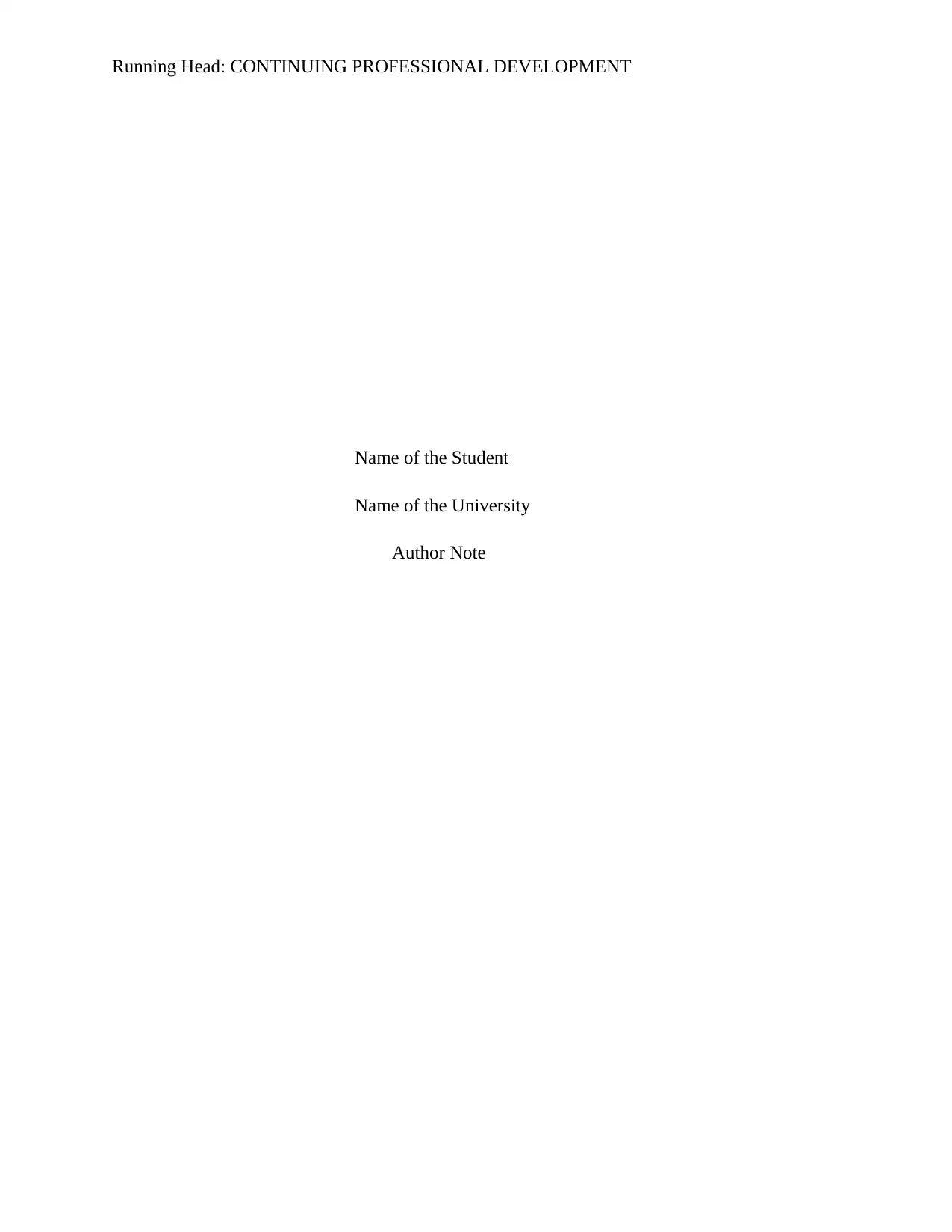
Running Head: CONTINUING PROFESSIONAL DEVELOPMENT
Name of the Student
Name of the University
Author Note
Name of the Student
Name of the University
Author Note
Paraphrase This Document
Need a fresh take? Get an instant paraphrase of this document with our AI Paraphraser
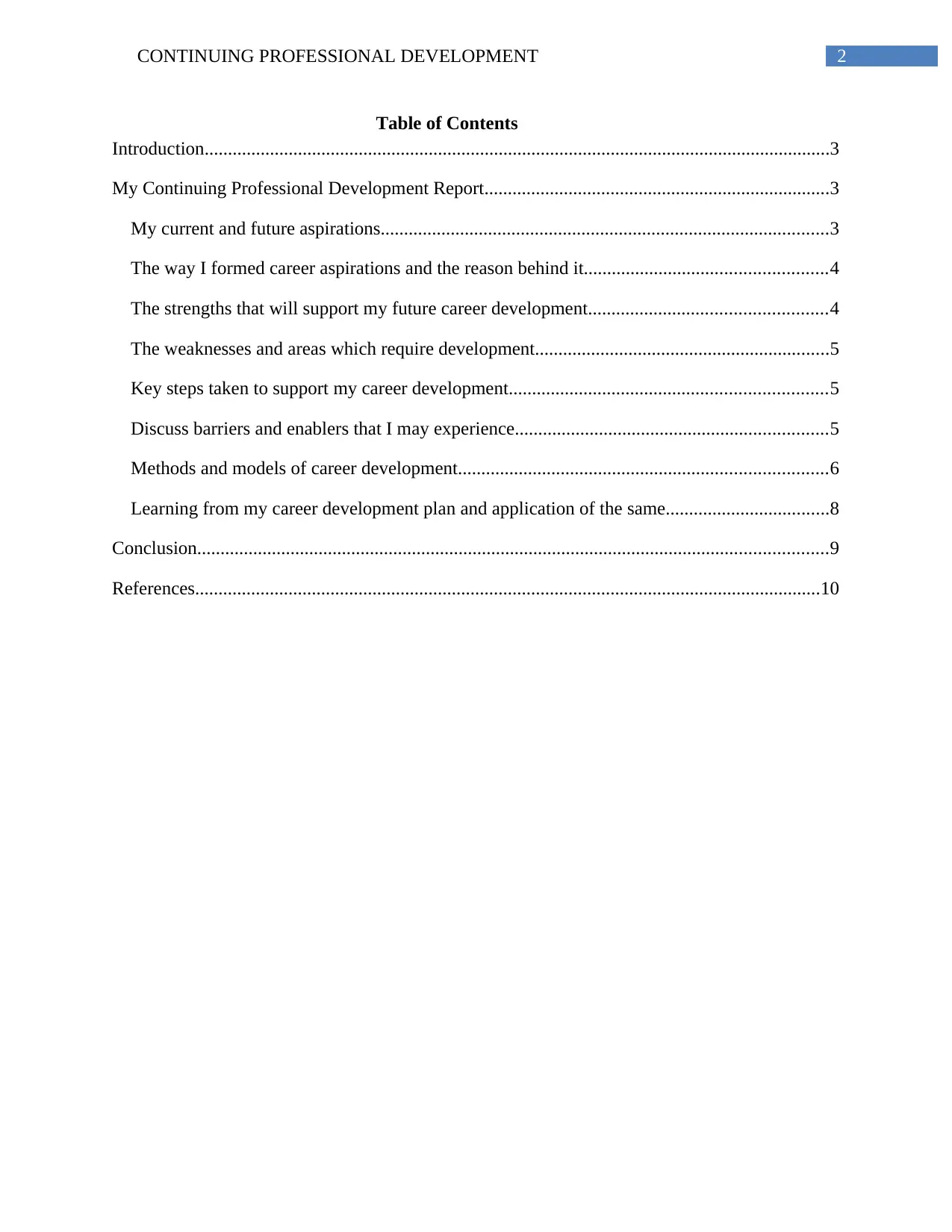
2CONTINUING PROFESSIONAL DEVELOPMENT
Table of Contents
Introduction......................................................................................................................................3
My Continuing Professional Development Report..........................................................................3
My current and future aspirations................................................................................................3
The way I formed career aspirations and the reason behind it....................................................4
The strengths that will support my future career development...................................................4
The weaknesses and areas which require development...............................................................5
Key steps taken to support my career development....................................................................5
Discuss barriers and enablers that I may experience...................................................................5
Methods and models of career development...............................................................................6
Learning from my career development plan and application of the same...................................8
Conclusion.......................................................................................................................................9
References......................................................................................................................................10
Table of Contents
Introduction......................................................................................................................................3
My Continuing Professional Development Report..........................................................................3
My current and future aspirations................................................................................................3
The way I formed career aspirations and the reason behind it....................................................4
The strengths that will support my future career development...................................................4
The weaknesses and areas which require development...............................................................5
Key steps taken to support my career development....................................................................5
Discuss barriers and enablers that I may experience...................................................................5
Methods and models of career development...............................................................................6
Learning from my career development plan and application of the same...................................8
Conclusion.......................................................................................................................................9
References......................................................................................................................................10
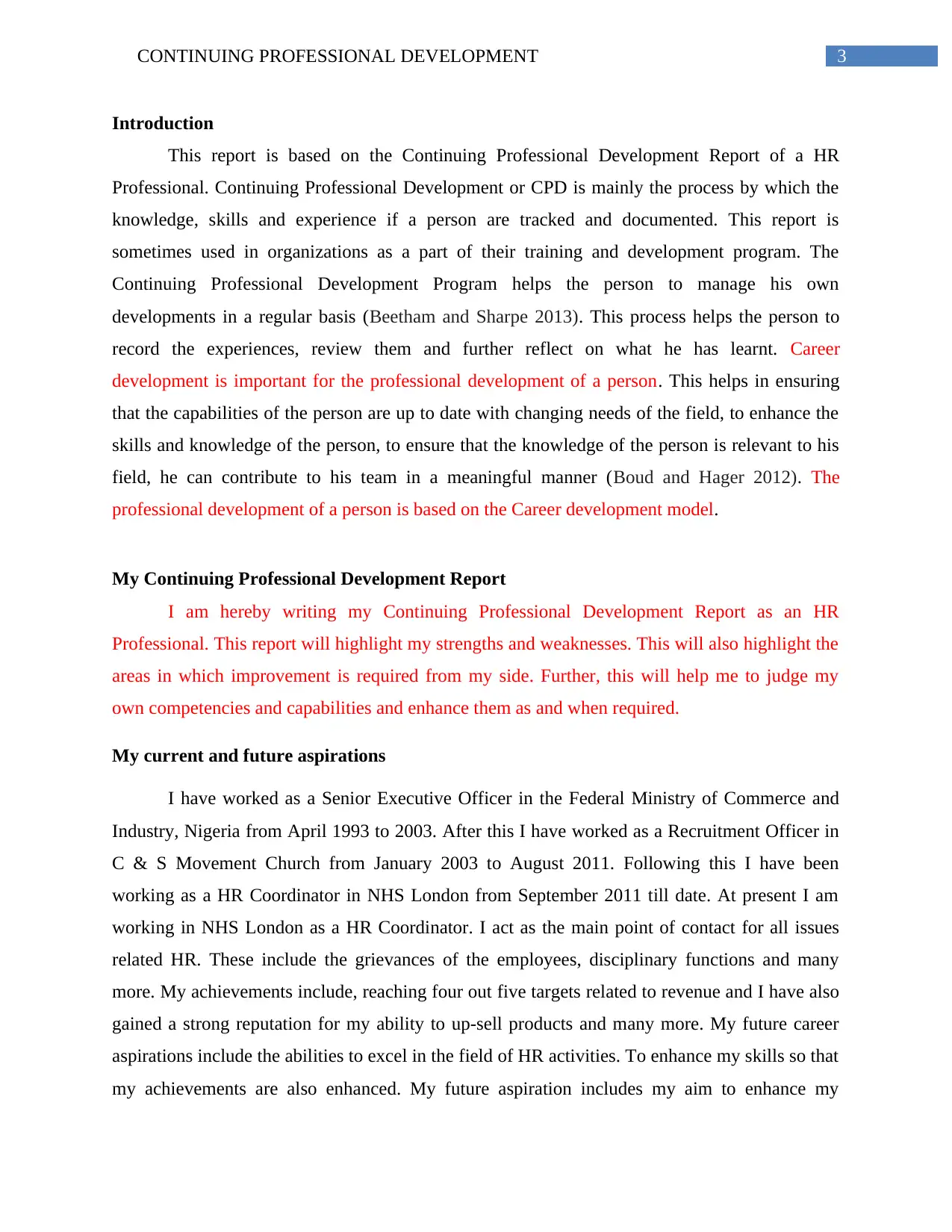
3CONTINUING PROFESSIONAL DEVELOPMENT
Introduction
This report is based on the Continuing Professional Development Report of a HR
Professional. Continuing Professional Development or CPD is mainly the process by which the
knowledge, skills and experience if a person are tracked and documented. This report is
sometimes used in organizations as a part of their training and development program. The
Continuing Professional Development Program helps the person to manage his own
developments in a regular basis (Beetham and Sharpe 2013). This process helps the person to
record the experiences, review them and further reflect on what he has learnt. Career
development is important for the professional development of a person. This helps in ensuring
that the capabilities of the person are up to date with changing needs of the field, to enhance the
skills and knowledge of the person, to ensure that the knowledge of the person is relevant to his
field, he can contribute to his team in a meaningful manner (Boud and Hager 2012). The
professional development of a person is based on the Career development model.
My Continuing Professional Development Report
I am hereby writing my Continuing Professional Development Report as an HR
Professional. This report will highlight my strengths and weaknesses. This will also highlight the
areas in which improvement is required from my side. Further, this will help me to judge my
own competencies and capabilities and enhance them as and when required.
My current and future aspirations
I have worked as a Senior Executive Officer in the Federal Ministry of Commerce and
Industry, Nigeria from April 1993 to 2003. After this I have worked as a Recruitment Officer in
C & S Movement Church from January 2003 to August 2011. Following this I have been
working as a HR Coordinator in NHS London from September 2011 till date. At present I am
working in NHS London as a HR Coordinator. I act as the main point of contact for all issues
related HR. These include the grievances of the employees, disciplinary functions and many
more. My achievements include, reaching four out five targets related to revenue and I have also
gained a strong reputation for my ability to up-sell products and many more. My future career
aspirations include the abilities to excel in the field of HR activities. To enhance my skills so that
my achievements are also enhanced. My future aspiration includes my aim to enhance my
Introduction
This report is based on the Continuing Professional Development Report of a HR
Professional. Continuing Professional Development or CPD is mainly the process by which the
knowledge, skills and experience if a person are tracked and documented. This report is
sometimes used in organizations as a part of their training and development program. The
Continuing Professional Development Program helps the person to manage his own
developments in a regular basis (Beetham and Sharpe 2013). This process helps the person to
record the experiences, review them and further reflect on what he has learnt. Career
development is important for the professional development of a person. This helps in ensuring
that the capabilities of the person are up to date with changing needs of the field, to enhance the
skills and knowledge of the person, to ensure that the knowledge of the person is relevant to his
field, he can contribute to his team in a meaningful manner (Boud and Hager 2012). The
professional development of a person is based on the Career development model.
My Continuing Professional Development Report
I am hereby writing my Continuing Professional Development Report as an HR
Professional. This report will highlight my strengths and weaknesses. This will also highlight the
areas in which improvement is required from my side. Further, this will help me to judge my
own competencies and capabilities and enhance them as and when required.
My current and future aspirations
I have worked as a Senior Executive Officer in the Federal Ministry of Commerce and
Industry, Nigeria from April 1993 to 2003. After this I have worked as a Recruitment Officer in
C & S Movement Church from January 2003 to August 2011. Following this I have been
working as a HR Coordinator in NHS London from September 2011 till date. At present I am
working in NHS London as a HR Coordinator. I act as the main point of contact for all issues
related HR. These include the grievances of the employees, disciplinary functions and many
more. My achievements include, reaching four out five targets related to revenue and I have also
gained a strong reputation for my ability to up-sell products and many more. My future career
aspirations include the abilities to excel in the field of HR activities. To enhance my skills so that
my achievements are also enhanced. My future aspiration includes my aim to enhance my
⊘ This is a preview!⊘
Do you want full access?
Subscribe today to unlock all pages.

Trusted by 1+ million students worldwide
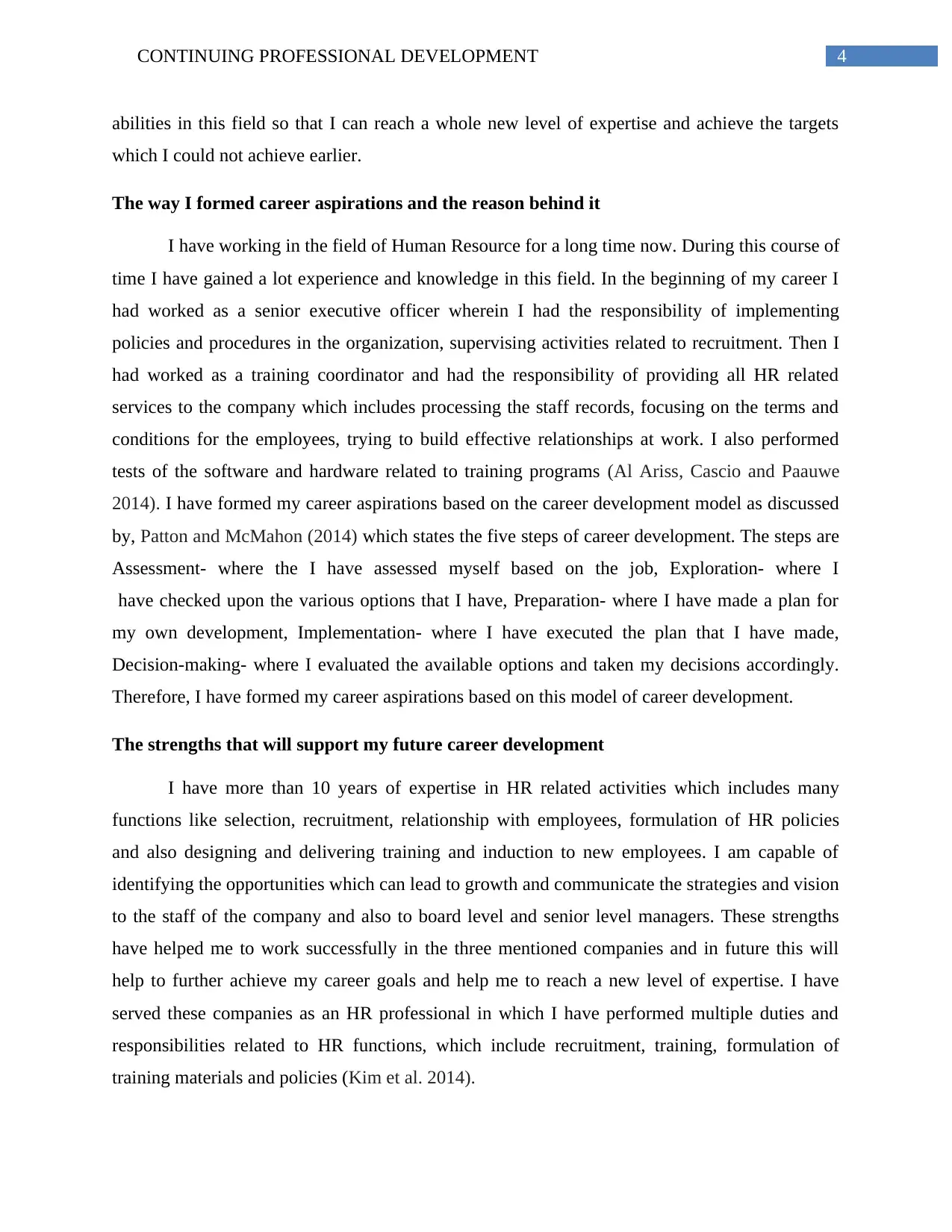
4CONTINUING PROFESSIONAL DEVELOPMENT
abilities in this field so that I can reach a whole new level of expertise and achieve the targets
which I could not achieve earlier.
The way I formed career aspirations and the reason behind it
I have working in the field of Human Resource for a long time now. During this course of
time I have gained a lot experience and knowledge in this field. In the beginning of my career I
had worked as a senior executive officer wherein I had the responsibility of implementing
policies and procedures in the organization, supervising activities related to recruitment. Then I
had worked as a training coordinator and had the responsibility of providing all HR related
services to the company which includes processing the staff records, focusing on the terms and
conditions for the employees, trying to build effective relationships at work. I also performed
tests of the software and hardware related to training programs (Al Ariss, Cascio and Paauwe
2014). I have formed my career aspirations based on the career development model as discussed
by, Patton and McMahon (2014) which states the five steps of career development. The steps are
Assessment- where the I have assessed myself based on the job, Exploration- where I
have checked upon the various options that I have, Preparation- where I have made a plan for
my own development, Implementation- where I have executed the plan that I have made,
Decision-making- where I evaluated the available options and taken my decisions accordingly.
Therefore, I have formed my career aspirations based on this model of career development.
The strengths that will support my future career development
I have more than 10 years of expertise in HR related activities which includes many
functions like selection, recruitment, relationship with employees, formulation of HR policies
and also designing and delivering training and induction to new employees. I am capable of
identifying the opportunities which can lead to growth and communicate the strategies and vision
to the staff of the company and also to board level and senior level managers. These strengths
have helped me to work successfully in the three mentioned companies and in future this will
help to further achieve my career goals and help me to reach a new level of expertise. I have
served these companies as an HR professional in which I have performed multiple duties and
responsibilities related to HR functions, which include recruitment, training, formulation of
training materials and policies (Kim et al. 2014).
abilities in this field so that I can reach a whole new level of expertise and achieve the targets
which I could not achieve earlier.
The way I formed career aspirations and the reason behind it
I have working in the field of Human Resource for a long time now. During this course of
time I have gained a lot experience and knowledge in this field. In the beginning of my career I
had worked as a senior executive officer wherein I had the responsibility of implementing
policies and procedures in the organization, supervising activities related to recruitment. Then I
had worked as a training coordinator and had the responsibility of providing all HR related
services to the company which includes processing the staff records, focusing on the terms and
conditions for the employees, trying to build effective relationships at work. I also performed
tests of the software and hardware related to training programs (Al Ariss, Cascio and Paauwe
2014). I have formed my career aspirations based on the career development model as discussed
by, Patton and McMahon (2014) which states the five steps of career development. The steps are
Assessment- where the I have assessed myself based on the job, Exploration- where I
have checked upon the various options that I have, Preparation- where I have made a plan for
my own development, Implementation- where I have executed the plan that I have made,
Decision-making- where I evaluated the available options and taken my decisions accordingly.
Therefore, I have formed my career aspirations based on this model of career development.
The strengths that will support my future career development
I have more than 10 years of expertise in HR related activities which includes many
functions like selection, recruitment, relationship with employees, formulation of HR policies
and also designing and delivering training and induction to new employees. I am capable of
identifying the opportunities which can lead to growth and communicate the strategies and vision
to the staff of the company and also to board level and senior level managers. These strengths
have helped me to work successfully in the three mentioned companies and in future this will
help to further achieve my career goals and help me to reach a new level of expertise. I have
served these companies as an HR professional in which I have performed multiple duties and
responsibilities related to HR functions, which include recruitment, training, formulation of
training materials and policies (Kim et al. 2014).
Paraphrase This Document
Need a fresh take? Get an instant paraphrase of this document with our AI Paraphraser
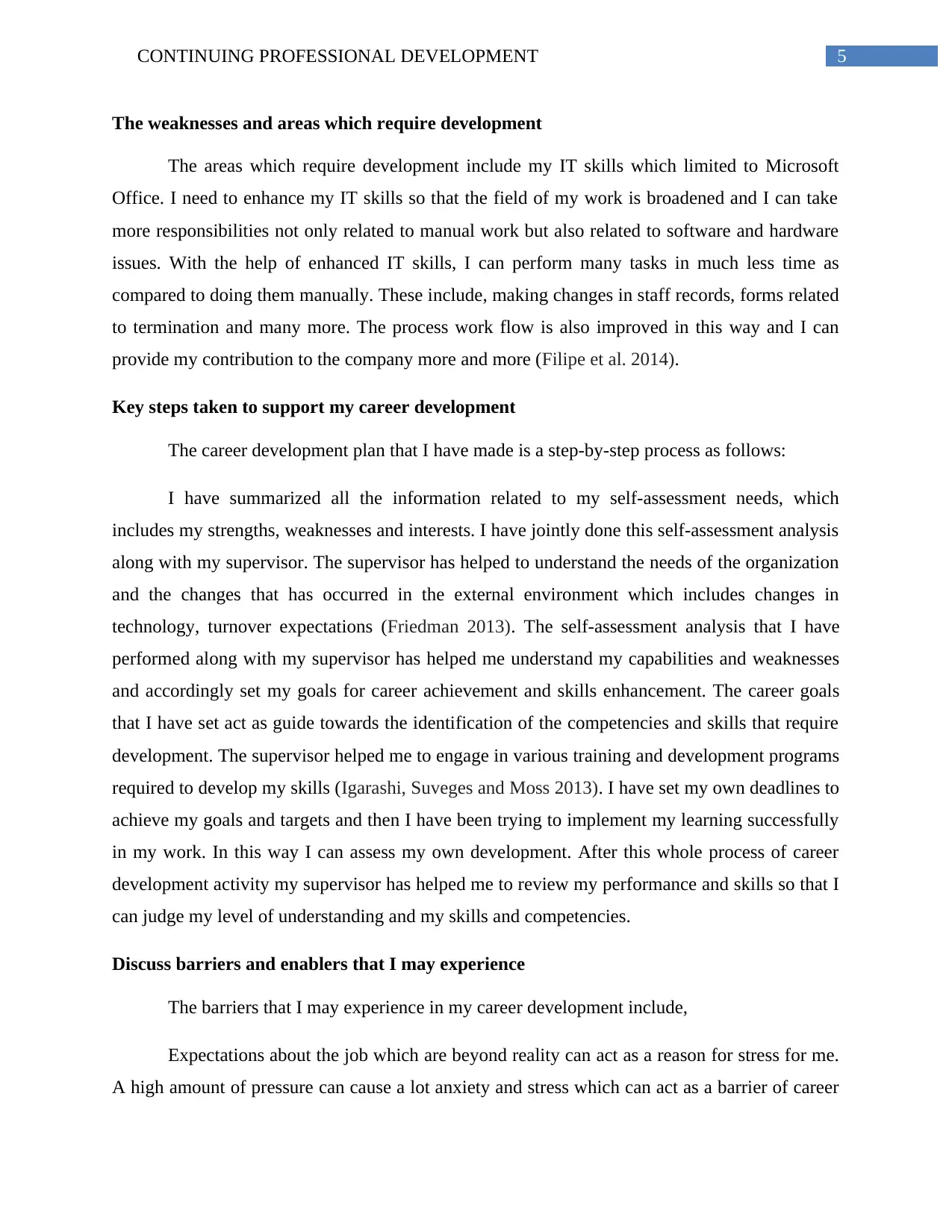
5CONTINUING PROFESSIONAL DEVELOPMENT
The weaknesses and areas which require development
The areas which require development include my IT skills which limited to Microsoft
Office. I need to enhance my IT skills so that the field of my work is broadened and I can take
more responsibilities not only related to manual work but also related to software and hardware
issues. With the help of enhanced IT skills, I can perform many tasks in much less time as
compared to doing them manually. These include, making changes in staff records, forms related
to termination and many more. The process work flow is also improved in this way and I can
provide my contribution to the company more and more (Filipe et al. 2014).
Key steps taken to support my career development
The career development plan that I have made is a step-by-step process as follows:
I have summarized all the information related to my self-assessment needs, which
includes my strengths, weaknesses and interests. I have jointly done this self-assessment analysis
along with my supervisor. The supervisor has helped to understand the needs of the organization
and the changes that has occurred in the external environment which includes changes in
technology, turnover expectations (Friedman 2013). The self-assessment analysis that I have
performed along with my supervisor has helped me understand my capabilities and weaknesses
and accordingly set my goals for career achievement and skills enhancement. The career goals
that I have set act as guide towards the identification of the competencies and skills that require
development. The supervisor helped me to engage in various training and development programs
required to develop my skills (Igarashi, Suveges and Moss 2013). I have set my own deadlines to
achieve my goals and targets and then I have been trying to implement my learning successfully
in my work. In this way I can assess my own development. After this whole process of career
development activity my supervisor has helped me to review my performance and skills so that I
can judge my level of understanding and my skills and competencies.
Discuss barriers and enablers that I may experience
The barriers that I may experience in my career development include,
Expectations about the job which are beyond reality can act as a reason for stress for me.
A high amount of pressure can cause a lot anxiety and stress which can act as a barrier of career
The weaknesses and areas which require development
The areas which require development include my IT skills which limited to Microsoft
Office. I need to enhance my IT skills so that the field of my work is broadened and I can take
more responsibilities not only related to manual work but also related to software and hardware
issues. With the help of enhanced IT skills, I can perform many tasks in much less time as
compared to doing them manually. These include, making changes in staff records, forms related
to termination and many more. The process work flow is also improved in this way and I can
provide my contribution to the company more and more (Filipe et al. 2014).
Key steps taken to support my career development
The career development plan that I have made is a step-by-step process as follows:
I have summarized all the information related to my self-assessment needs, which
includes my strengths, weaknesses and interests. I have jointly done this self-assessment analysis
along with my supervisor. The supervisor has helped to understand the needs of the organization
and the changes that has occurred in the external environment which includes changes in
technology, turnover expectations (Friedman 2013). The self-assessment analysis that I have
performed along with my supervisor has helped me understand my capabilities and weaknesses
and accordingly set my goals for career achievement and skills enhancement. The career goals
that I have set act as guide towards the identification of the competencies and skills that require
development. The supervisor helped me to engage in various training and development programs
required to develop my skills (Igarashi, Suveges and Moss 2013). I have set my own deadlines to
achieve my goals and targets and then I have been trying to implement my learning successfully
in my work. In this way I can assess my own development. After this whole process of career
development activity my supervisor has helped me to review my performance and skills so that I
can judge my level of understanding and my skills and competencies.
Discuss barriers and enablers that I may experience
The barriers that I may experience in my career development include,
Expectations about the job which are beyond reality can act as a reason for stress for me.
A high amount of pressure can cause a lot anxiety and stress which can act as a barrier of career
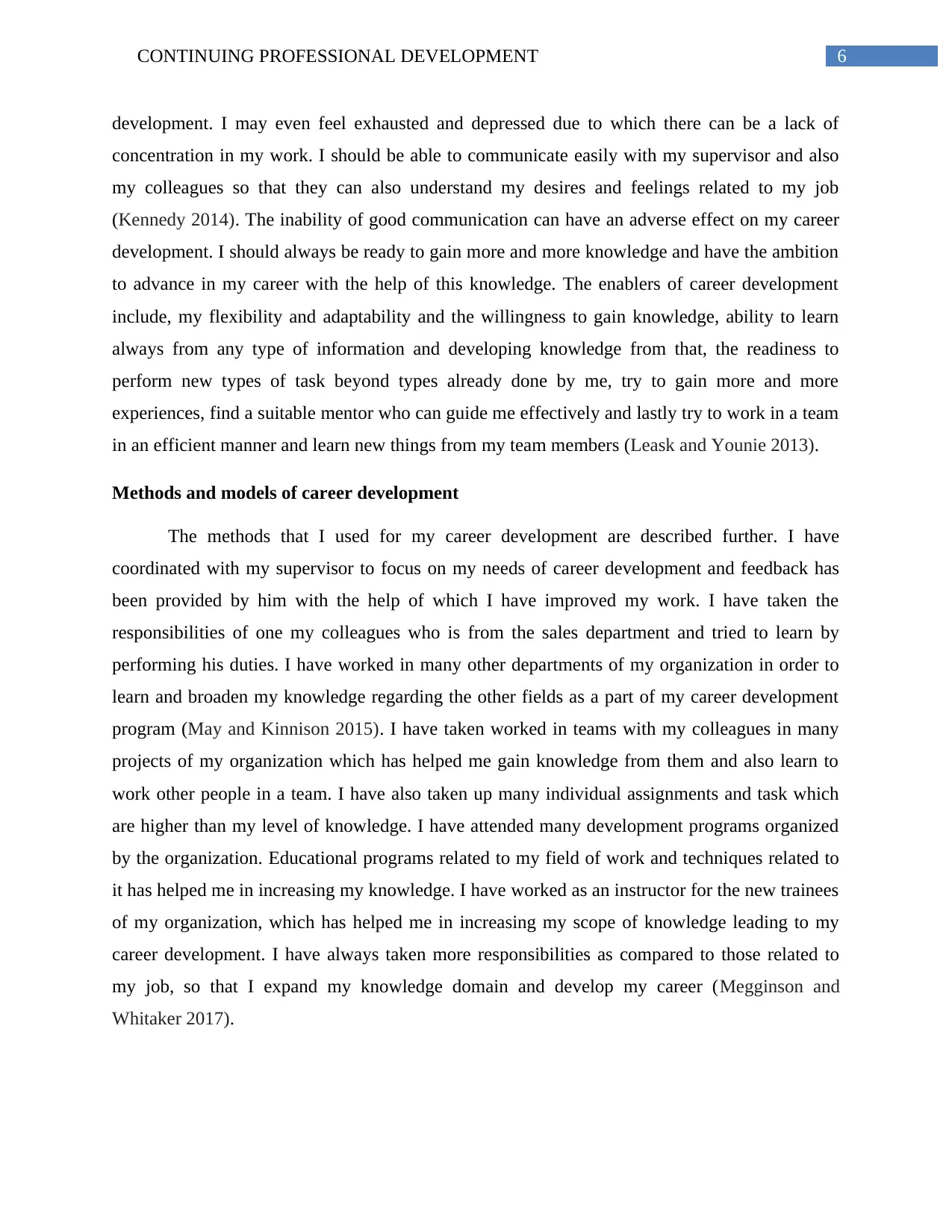
6CONTINUING PROFESSIONAL DEVELOPMENT
development. I may even feel exhausted and depressed due to which there can be a lack of
concentration in my work. I should be able to communicate easily with my supervisor and also
my colleagues so that they can also understand my desires and feelings related to my job
(Kennedy 2014). The inability of good communication can have an adverse effect on my career
development. I should always be ready to gain more and more knowledge and have the ambition
to advance in my career with the help of this knowledge. The enablers of career development
include, my flexibility and adaptability and the willingness to gain knowledge, ability to learn
always from any type of information and developing knowledge from that, the readiness to
perform new types of task beyond types already done by me, try to gain more and more
experiences, find a suitable mentor who can guide me effectively and lastly try to work in a team
in an efficient manner and learn new things from my team members (Leask and Younie 2013).
Methods and models of career development
The methods that I used for my career development are described further. I have
coordinated with my supervisor to focus on my needs of career development and feedback has
been provided by him with the help of which I have improved my work. I have taken the
responsibilities of one my colleagues who is from the sales department and tried to learn by
performing his duties. I have worked in many other departments of my organization in order to
learn and broaden my knowledge regarding the other fields as a part of my career development
program (May and Kinnison 2015). I have taken worked in teams with my colleagues in many
projects of my organization which has helped me gain knowledge from them and also learn to
work other people in a team. I have also taken up many individual assignments and task which
are higher than my level of knowledge. I have attended many development programs organized
by the organization. Educational programs related to my field of work and techniques related to
it has helped me in increasing my knowledge. I have worked as an instructor for the new trainees
of my organization, which has helped me in increasing my scope of knowledge leading to my
career development. I have always taken more responsibilities as compared to those related to
my job, so that I expand my knowledge domain and develop my career (Megginson and
Whitaker 2017).
development. I may even feel exhausted and depressed due to which there can be a lack of
concentration in my work. I should be able to communicate easily with my supervisor and also
my colleagues so that they can also understand my desires and feelings related to my job
(Kennedy 2014). The inability of good communication can have an adverse effect on my career
development. I should always be ready to gain more and more knowledge and have the ambition
to advance in my career with the help of this knowledge. The enablers of career development
include, my flexibility and adaptability and the willingness to gain knowledge, ability to learn
always from any type of information and developing knowledge from that, the readiness to
perform new types of task beyond types already done by me, try to gain more and more
experiences, find a suitable mentor who can guide me effectively and lastly try to work in a team
in an efficient manner and learn new things from my team members (Leask and Younie 2013).
Methods and models of career development
The methods that I used for my career development are described further. I have
coordinated with my supervisor to focus on my needs of career development and feedback has
been provided by him with the help of which I have improved my work. I have taken the
responsibilities of one my colleagues who is from the sales department and tried to learn by
performing his duties. I have worked in many other departments of my organization in order to
learn and broaden my knowledge regarding the other fields as a part of my career development
program (May and Kinnison 2015). I have taken worked in teams with my colleagues in many
projects of my organization which has helped me gain knowledge from them and also learn to
work other people in a team. I have also taken up many individual assignments and task which
are higher than my level of knowledge. I have attended many development programs organized
by the organization. Educational programs related to my field of work and techniques related to
it has helped me in increasing my knowledge. I have worked as an instructor for the new trainees
of my organization, which has helped me in increasing my scope of knowledge leading to my
career development. I have always taken more responsibilities as compared to those related to
my job, so that I expand my knowledge domain and develop my career (Megginson and
Whitaker 2017).
⊘ This is a preview!⊘
Do you want full access?
Subscribe today to unlock all pages.

Trusted by 1+ million students worldwide
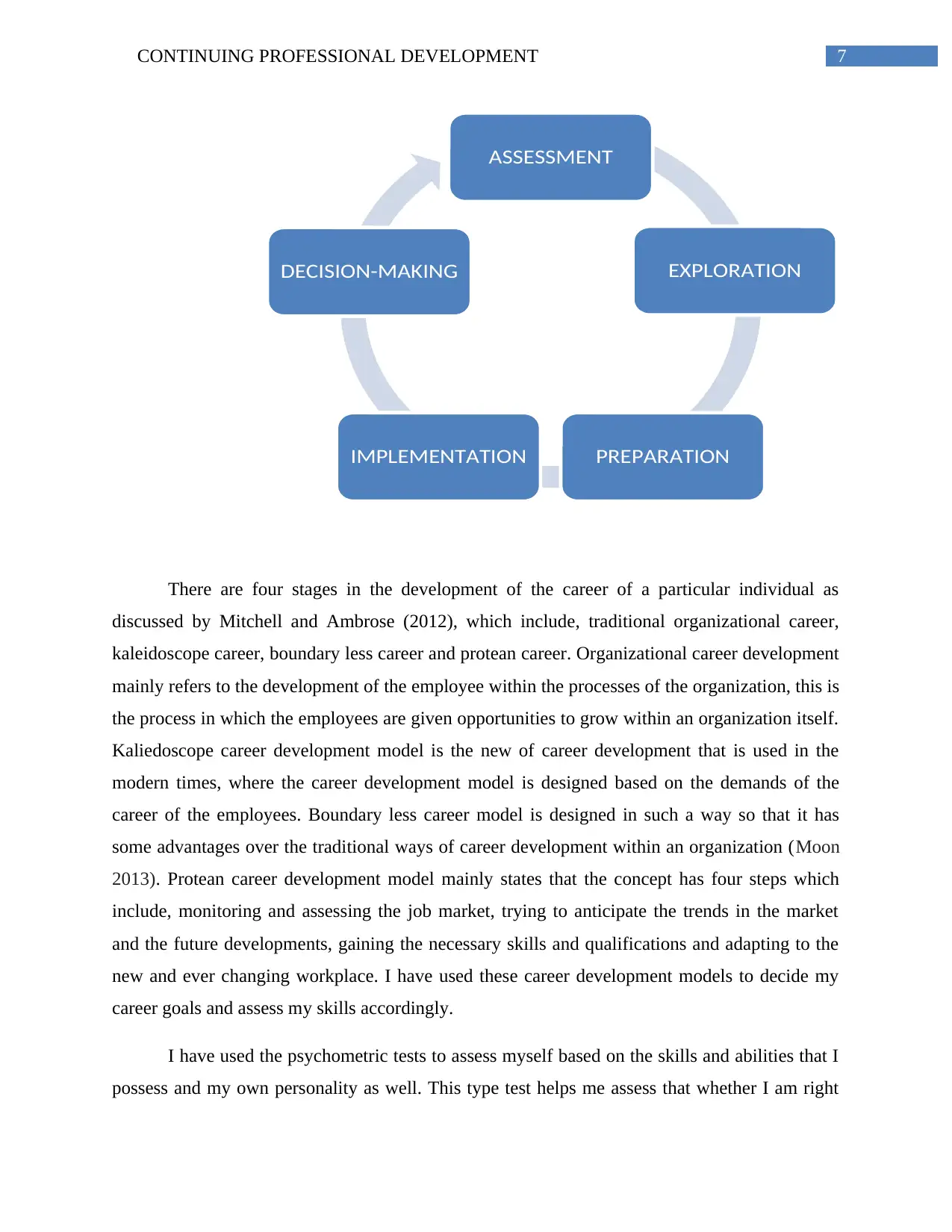
7CONTINUING PROFESSIONAL DEVELOPMENT
There are four stages in the development of the career of a particular individual as
discussed by Mitchell and Ambrose (2012), which include, traditional organizational career,
kaleidoscope career, boundary less career and protean career. Organizational career development
mainly refers to the development of the employee within the processes of the organization, this is
the process in which the employees are given opportunities to grow within an organization itself.
Kaliedoscope career development model is the new of career development that is used in the
modern times, where the career development model is designed based on the demands of the
career of the employees. Boundary less career model is designed in such a way so that it has
some advantages over the traditional ways of career development within an organization (Moon
2013). Protean career development model mainly states that the concept has four steps which
include, monitoring and assessing the job market, trying to anticipate the trends in the market
and the future developments, gaining the necessary skills and qualifications and adapting to the
new and ever changing workplace. I have used these career development models to decide my
career goals and assess my skills accordingly.
I have used the psychometric tests to assess myself based on the skills and abilities that I
possess and my own personality as well. This type test helps me assess that whether I am right
ASSESSMENT
EXPLORATION
PREPARATIONIMPLEMENTATION
DECISION-MAKING
There are four stages in the development of the career of a particular individual as
discussed by Mitchell and Ambrose (2012), which include, traditional organizational career,
kaleidoscope career, boundary less career and protean career. Organizational career development
mainly refers to the development of the employee within the processes of the organization, this is
the process in which the employees are given opportunities to grow within an organization itself.
Kaliedoscope career development model is the new of career development that is used in the
modern times, where the career development model is designed based on the demands of the
career of the employees. Boundary less career model is designed in such a way so that it has
some advantages over the traditional ways of career development within an organization (Moon
2013). Protean career development model mainly states that the concept has four steps which
include, monitoring and assessing the job market, trying to anticipate the trends in the market
and the future developments, gaining the necessary skills and qualifications and adapting to the
new and ever changing workplace. I have used these career development models to decide my
career goals and assess my skills accordingly.
I have used the psychometric tests to assess myself based on the skills and abilities that I
possess and my own personality as well. This type test helps me assess that whether I am right
ASSESSMENT
EXPLORATION
PREPARATIONIMPLEMENTATION
DECISION-MAKING
Paraphrase This Document
Need a fresh take? Get an instant paraphrase of this document with our AI Paraphraser
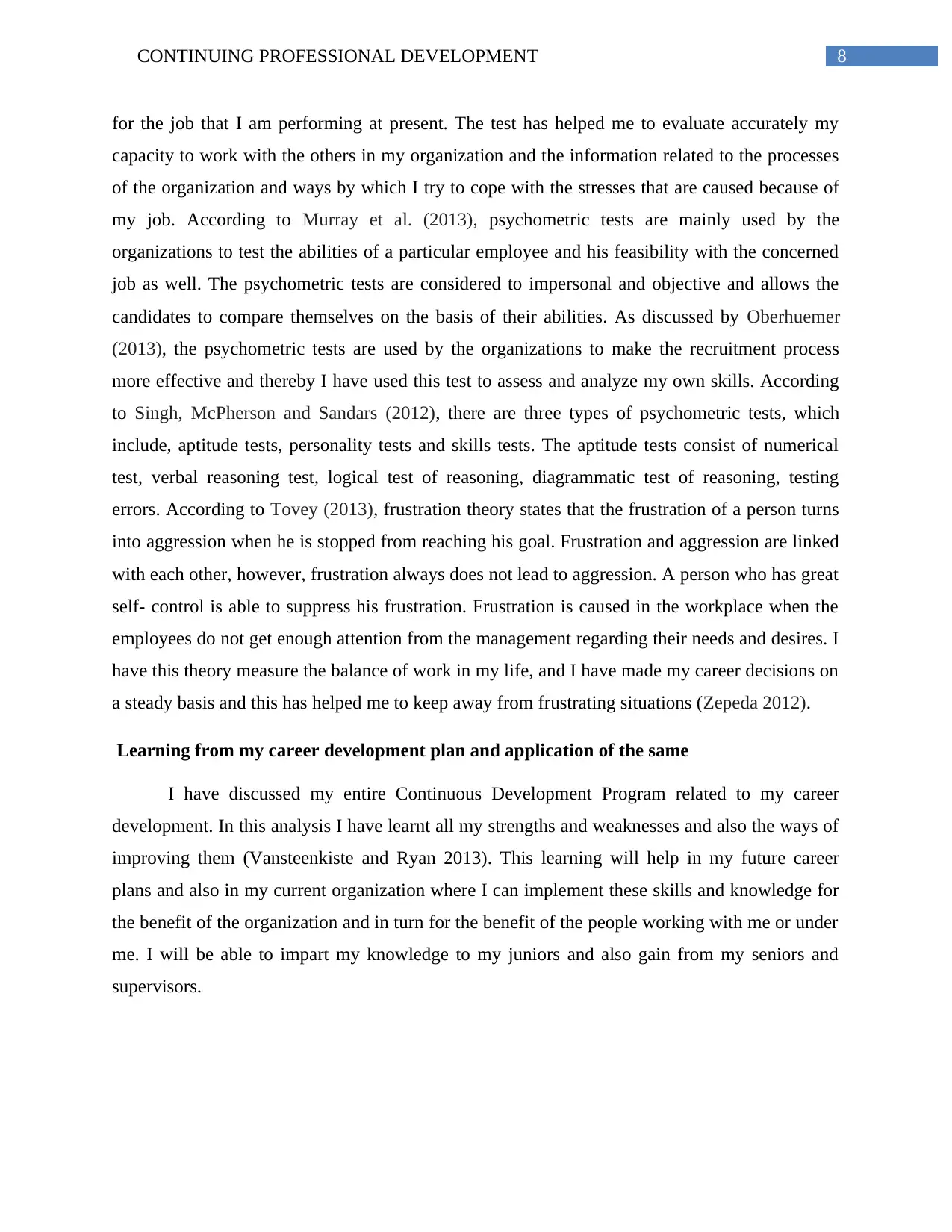
8CONTINUING PROFESSIONAL DEVELOPMENT
for the job that I am performing at present. The test has helped me to evaluate accurately my
capacity to work with the others in my organization and the information related to the processes
of the organization and ways by which I try to cope with the stresses that are caused because of
my job. According to Murray et al. (2013), psychometric tests are mainly used by the
organizations to test the abilities of a particular employee and his feasibility with the concerned
job as well. The psychometric tests are considered to impersonal and objective and allows the
candidates to compare themselves on the basis of their abilities. As discussed by Oberhuemer
(2013), the psychometric tests are used by the organizations to make the recruitment process
more effective and thereby I have used this test to assess and analyze my own skills. According
to Singh, McPherson and Sandars (2012), there are three types of psychometric tests, which
include, aptitude tests, personality tests and skills tests. The aptitude tests consist of numerical
test, verbal reasoning test, logical test of reasoning, diagrammatic test of reasoning, testing
errors. According to Tovey (2013), frustration theory states that the frustration of a person turns
into aggression when he is stopped from reaching his goal. Frustration and aggression are linked
with each other, however, frustration always does not lead to aggression. A person who has great
self- control is able to suppress his frustration. Frustration is caused in the workplace when the
employees do not get enough attention from the management regarding their needs and desires. I
have this theory measure the balance of work in my life, and I have made my career decisions on
a steady basis and this has helped me to keep away from frustrating situations (Zepeda 2012).
Learning from my career development plan and application of the same
I have discussed my entire Continuous Development Program related to my career
development. In this analysis I have learnt all my strengths and weaknesses and also the ways of
improving them (Vansteenkiste and Ryan 2013). This learning will help in my future career
plans and also in my current organization where I can implement these skills and knowledge for
the benefit of the organization and in turn for the benefit of the people working with me or under
me. I will be able to impart my knowledge to my juniors and also gain from my seniors and
supervisors.
for the job that I am performing at present. The test has helped me to evaluate accurately my
capacity to work with the others in my organization and the information related to the processes
of the organization and ways by which I try to cope with the stresses that are caused because of
my job. According to Murray et al. (2013), psychometric tests are mainly used by the
organizations to test the abilities of a particular employee and his feasibility with the concerned
job as well. The psychometric tests are considered to impersonal and objective and allows the
candidates to compare themselves on the basis of their abilities. As discussed by Oberhuemer
(2013), the psychometric tests are used by the organizations to make the recruitment process
more effective and thereby I have used this test to assess and analyze my own skills. According
to Singh, McPherson and Sandars (2012), there are three types of psychometric tests, which
include, aptitude tests, personality tests and skills tests. The aptitude tests consist of numerical
test, verbal reasoning test, logical test of reasoning, diagrammatic test of reasoning, testing
errors. According to Tovey (2013), frustration theory states that the frustration of a person turns
into aggression when he is stopped from reaching his goal. Frustration and aggression are linked
with each other, however, frustration always does not lead to aggression. A person who has great
self- control is able to suppress his frustration. Frustration is caused in the workplace when the
employees do not get enough attention from the management regarding their needs and desires. I
have this theory measure the balance of work in my life, and I have made my career decisions on
a steady basis and this has helped me to keep away from frustrating situations (Zepeda 2012).
Learning from my career development plan and application of the same
I have discussed my entire Continuous Development Program related to my career
development. In this analysis I have learnt all my strengths and weaknesses and also the ways of
improving them (Vansteenkiste and Ryan 2013). This learning will help in my future career
plans and also in my current organization where I can implement these skills and knowledge for
the benefit of the organization and in turn for the benefit of the people working with me or under
me. I will be able to impart my knowledge to my juniors and also gain from my seniors and
supervisors.
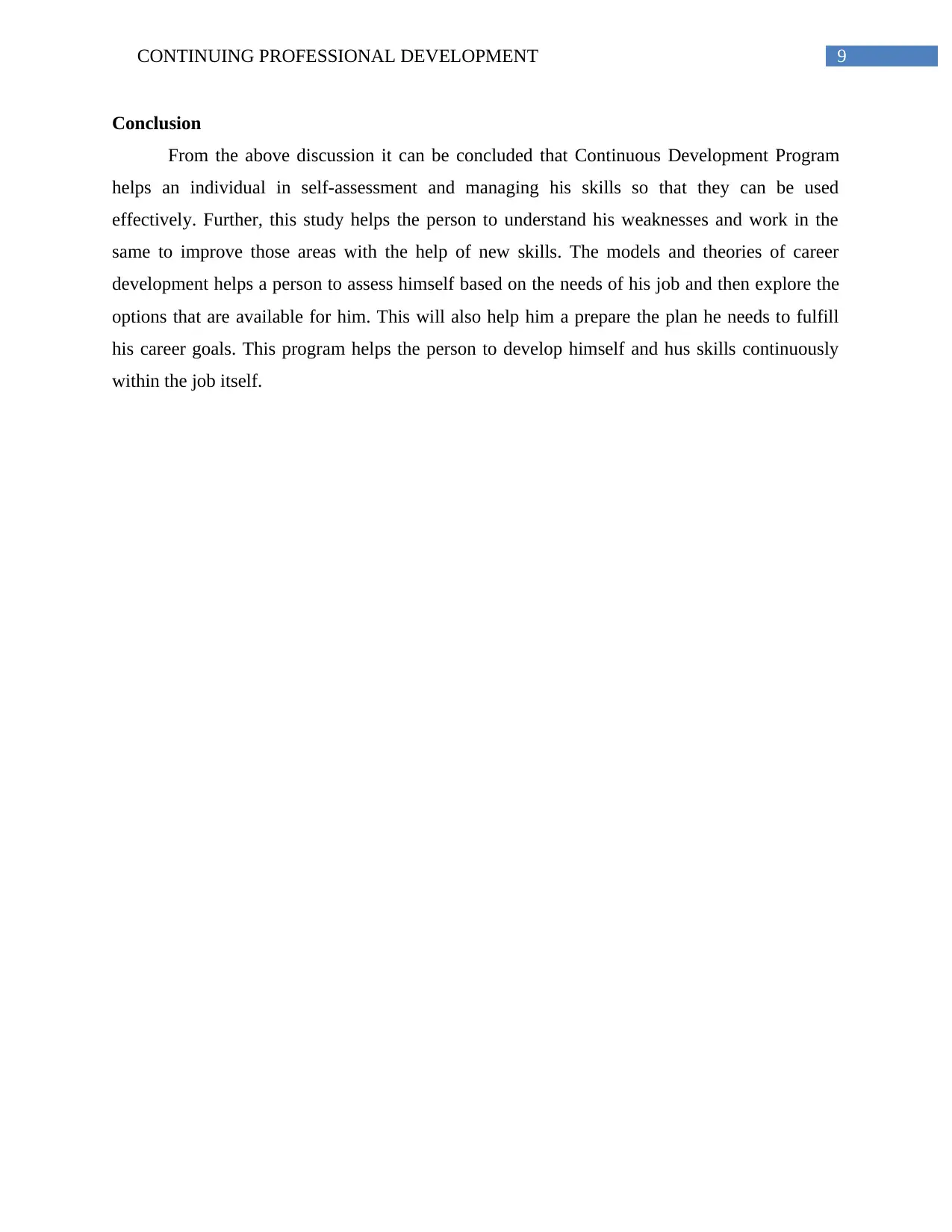
9CONTINUING PROFESSIONAL DEVELOPMENT
Conclusion
From the above discussion it can be concluded that Continuous Development Program
helps an individual in self-assessment and managing his skills so that they can be used
effectively. Further, this study helps the person to understand his weaknesses and work in the
same to improve those areas with the help of new skills. The models and theories of career
development helps a person to assess himself based on the needs of his job and then explore the
options that are available for him. This will also help him a prepare the plan he needs to fulfill
his career goals. This program helps the person to develop himself and hus skills continuously
within the job itself.
Conclusion
From the above discussion it can be concluded that Continuous Development Program
helps an individual in self-assessment and managing his skills so that they can be used
effectively. Further, this study helps the person to understand his weaknesses and work in the
same to improve those areas with the help of new skills. The models and theories of career
development helps a person to assess himself based on the needs of his job and then explore the
options that are available for him. This will also help him a prepare the plan he needs to fulfill
his career goals. This program helps the person to develop himself and hus skills continuously
within the job itself.
⊘ This is a preview!⊘
Do you want full access?
Subscribe today to unlock all pages.

Trusted by 1+ million students worldwide
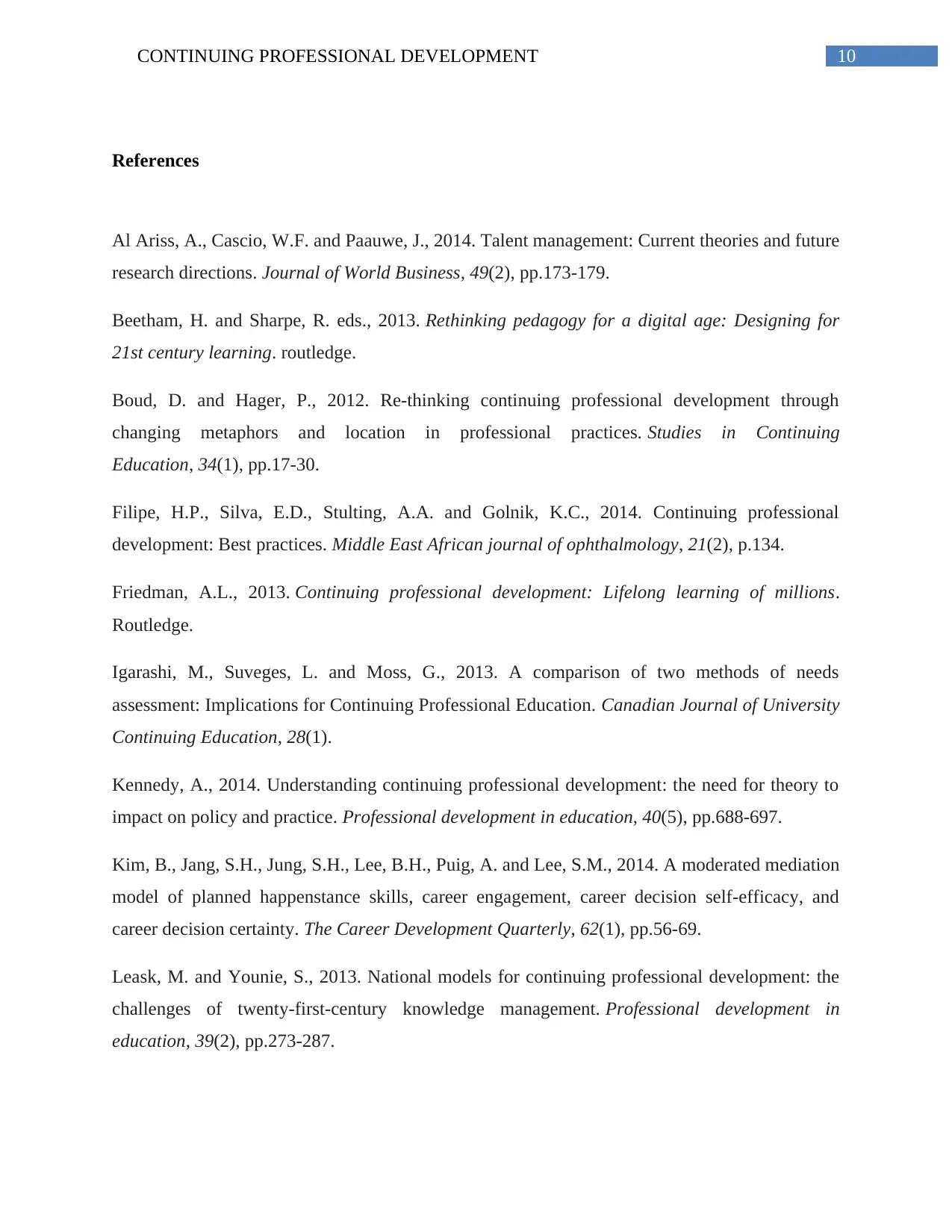
10CONTINUING PROFESSIONAL DEVELOPMENT
References
Al Ariss, A., Cascio, W.F. and Paauwe, J., 2014. Talent management: Current theories and future
research directions. Journal of World Business, 49(2), pp.173-179.
Beetham, H. and Sharpe, R. eds., 2013. Rethinking pedagogy for a digital age: Designing for
21st century learning. routledge.
Boud, D. and Hager, P., 2012. Re-thinking continuing professional development through
changing metaphors and location in professional practices. Studies in Continuing
Education, 34(1), pp.17-30.
Filipe, H.P., Silva, E.D., Stulting, A.A. and Golnik, K.C., 2014. Continuing professional
development: Best practices. Middle East African journal of ophthalmology, 21(2), p.134.
Friedman, A.L., 2013. Continuing professional development: Lifelong learning of millions.
Routledge.
Igarashi, M., Suveges, L. and Moss, G., 2013. A comparison of two methods of needs
assessment: Implications for Continuing Professional Education. Canadian Journal of University
Continuing Education, 28(1).
Kennedy, A., 2014. Understanding continuing professional development: the need for theory to
impact on policy and practice. Professional development in education, 40(5), pp.688-697.
Kim, B., Jang, S.H., Jung, S.H., Lee, B.H., Puig, A. and Lee, S.M., 2014. A moderated mediation
model of planned happenstance skills, career engagement, career decision self‐efficacy, and
career decision certainty. The Career Development Quarterly, 62(1), pp.56-69.
Leask, M. and Younie, S., 2013. National models for continuing professional development: the
challenges of twenty-first-century knowledge management. Professional development in
education, 39(2), pp.273-287.
References
Al Ariss, A., Cascio, W.F. and Paauwe, J., 2014. Talent management: Current theories and future
research directions. Journal of World Business, 49(2), pp.173-179.
Beetham, H. and Sharpe, R. eds., 2013. Rethinking pedagogy for a digital age: Designing for
21st century learning. routledge.
Boud, D. and Hager, P., 2012. Re-thinking continuing professional development through
changing metaphors and location in professional practices. Studies in Continuing
Education, 34(1), pp.17-30.
Filipe, H.P., Silva, E.D., Stulting, A.A. and Golnik, K.C., 2014. Continuing professional
development: Best practices. Middle East African journal of ophthalmology, 21(2), p.134.
Friedman, A.L., 2013. Continuing professional development: Lifelong learning of millions.
Routledge.
Igarashi, M., Suveges, L. and Moss, G., 2013. A comparison of two methods of needs
assessment: Implications for Continuing Professional Education. Canadian Journal of University
Continuing Education, 28(1).
Kennedy, A., 2014. Understanding continuing professional development: the need for theory to
impact on policy and practice. Professional development in education, 40(5), pp.688-697.
Kim, B., Jang, S.H., Jung, S.H., Lee, B.H., Puig, A. and Lee, S.M., 2014. A moderated mediation
model of planned happenstance skills, career engagement, career decision self‐efficacy, and
career decision certainty. The Career Development Quarterly, 62(1), pp.56-69.
Leask, M. and Younie, S., 2013. National models for continuing professional development: the
challenges of twenty-first-century knowledge management. Professional development in
education, 39(2), pp.273-287.
Paraphrase This Document
Need a fresh take? Get an instant paraphrase of this document with our AI Paraphraser
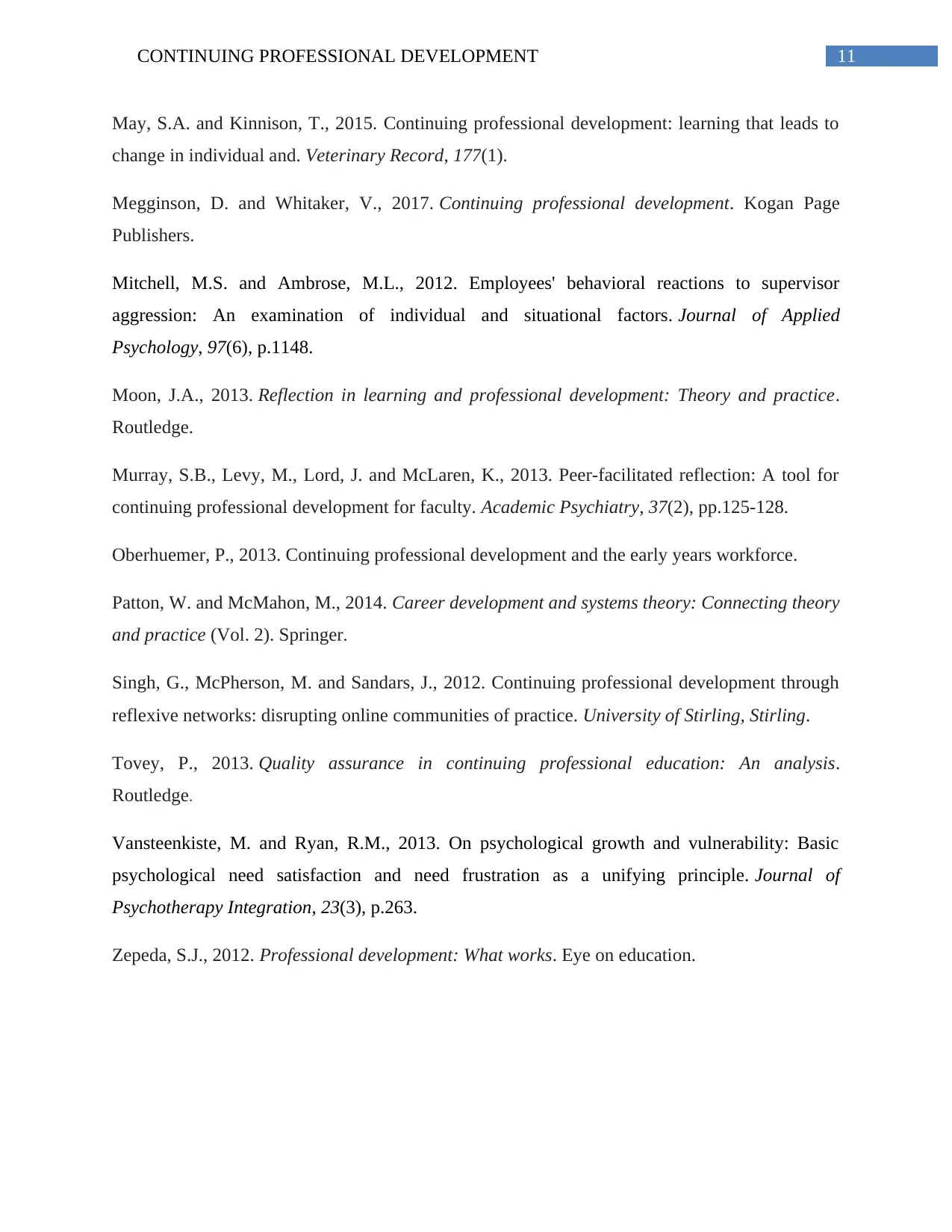
11CONTINUING PROFESSIONAL DEVELOPMENT
May, S.A. and Kinnison, T., 2015. Continuing professional development: learning that leads to
change in individual and. Veterinary Record, 177(1).
Megginson, D. and Whitaker, V., 2017. Continuing professional development. Kogan Page
Publishers.
Mitchell, M.S. and Ambrose, M.L., 2012. Employees' behavioral reactions to supervisor
aggression: An examination of individual and situational factors. Journal of Applied
Psychology, 97(6), p.1148.
Moon, J.A., 2013. Reflection in learning and professional development: Theory and practice.
Routledge.
Murray, S.B., Levy, M., Lord, J. and McLaren, K., 2013. Peer-facilitated reflection: A tool for
continuing professional development for faculty. Academic Psychiatry, 37(2), pp.125-128.
Oberhuemer, P., 2013. Continuing professional development and the early years workforce.
Patton, W. and McMahon, M., 2014. Career development and systems theory: Connecting theory
and practice (Vol. 2). Springer.
Singh, G., McPherson, M. and Sandars, J., 2012. Continuing professional development through
reflexive networks: disrupting online communities of practice. University of Stirling, Stirling.
Tovey, P., 2013. Quality assurance in continuing professional education: An analysis.
Routledge.
Vansteenkiste, M. and Ryan, R.M., 2013. On psychological growth and vulnerability: Basic
psychological need satisfaction and need frustration as a unifying principle. Journal of
Psychotherapy Integration, 23(3), p.263.
Zepeda, S.J., 2012. Professional development: What works. Eye on education.
May, S.A. and Kinnison, T., 2015. Continuing professional development: learning that leads to
change in individual and. Veterinary Record, 177(1).
Megginson, D. and Whitaker, V., 2017. Continuing professional development. Kogan Page
Publishers.
Mitchell, M.S. and Ambrose, M.L., 2012. Employees' behavioral reactions to supervisor
aggression: An examination of individual and situational factors. Journal of Applied
Psychology, 97(6), p.1148.
Moon, J.A., 2013. Reflection in learning and professional development: Theory and practice.
Routledge.
Murray, S.B., Levy, M., Lord, J. and McLaren, K., 2013. Peer-facilitated reflection: A tool for
continuing professional development for faculty. Academic Psychiatry, 37(2), pp.125-128.
Oberhuemer, P., 2013. Continuing professional development and the early years workforce.
Patton, W. and McMahon, M., 2014. Career development and systems theory: Connecting theory
and practice (Vol. 2). Springer.
Singh, G., McPherson, M. and Sandars, J., 2012. Continuing professional development through
reflexive networks: disrupting online communities of practice. University of Stirling, Stirling.
Tovey, P., 2013. Quality assurance in continuing professional education: An analysis.
Routledge.
Vansteenkiste, M. and Ryan, R.M., 2013. On psychological growth and vulnerability: Basic
psychological need satisfaction and need frustration as a unifying principle. Journal of
Psychotherapy Integration, 23(3), p.263.
Zepeda, S.J., 2012. Professional development: What works. Eye on education.
1 out of 11
Related Documents
Your All-in-One AI-Powered Toolkit for Academic Success.
+13062052269
info@desklib.com
Available 24*7 on WhatsApp / Email
![[object Object]](/_next/static/media/star-bottom.7253800d.svg)
Unlock your academic potential
Copyright © 2020–2025 A2Z Services. All Rights Reserved. Developed and managed by ZUCOL.




